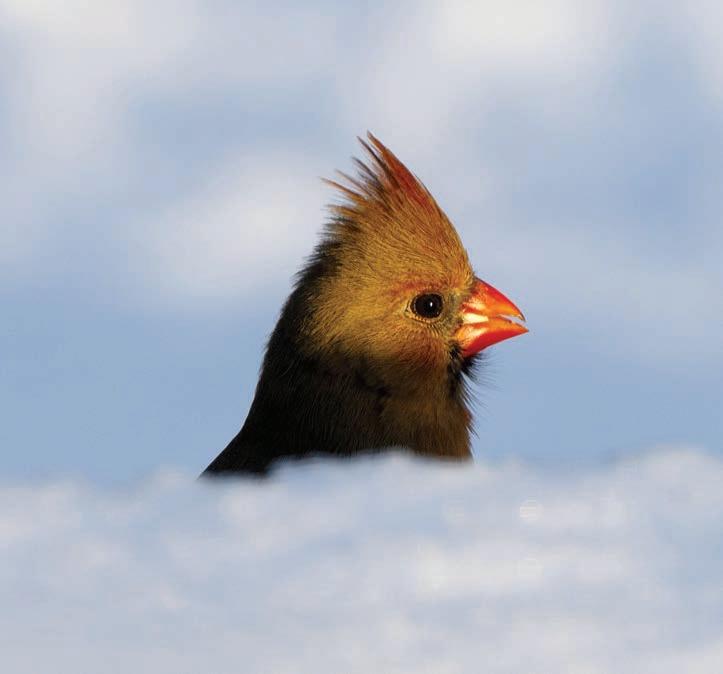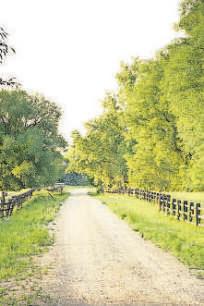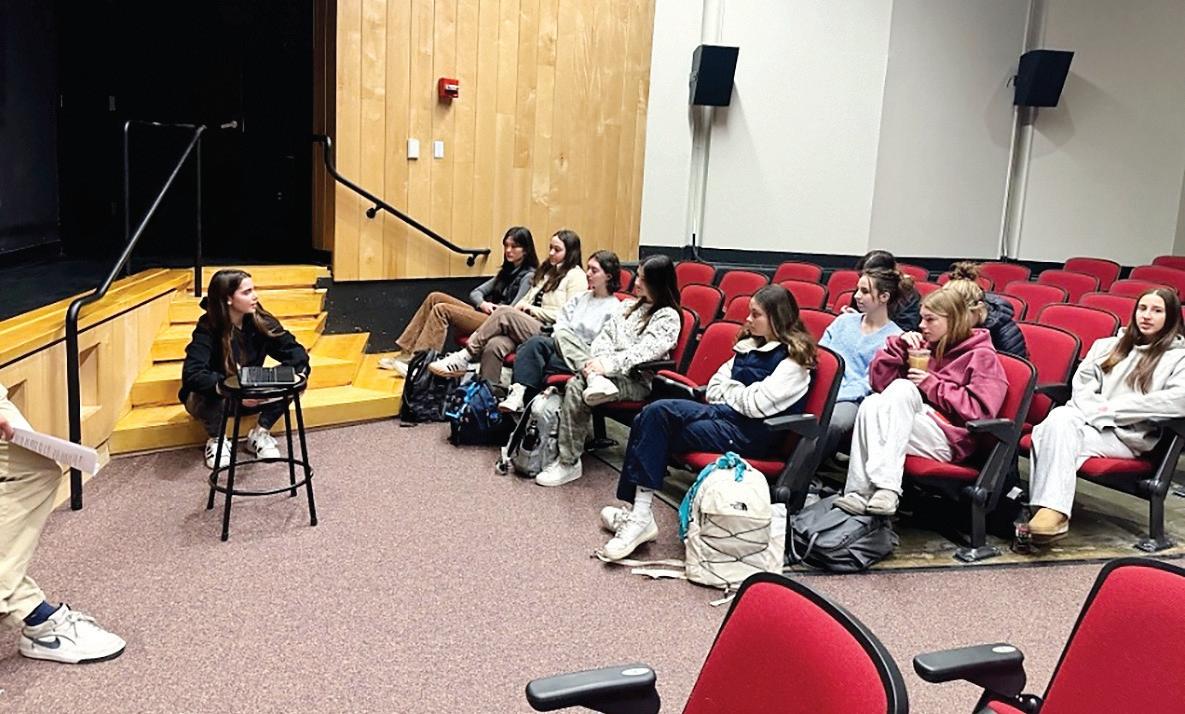Sergeant cited Police officer headed to court to answer for fatal Shelburne Road crash
Page 4

Page 7



Sergeant cited Police officer headed to court to answer for fatal Shelburne Road crash
Page 4

Page 7


BRIANA BRADY STAFF
The Shelburne wastewater treatment system is getting a structural update.
Last fall, voters approved a $38 million bond to pay for a $45 million project to consolidate the system from two treatment facilities to a single expanded treatment center, converting the second facility to a pump station.
The plan has since gone through a review process with
the state to evaluate any potential negative impacts. According to Jason Booth from Aldrich and Elliott, PC, the engineering firm designing the updates, the state found no significant impact from the project. Booth and Shelburne wastewater superintendent Chris Robinson presented those findings and plans for the update to the public two weeks ago at a selectboard meeting.
The project is now in a 30-day public comment period.
The current wastewater treat-

ment facilities in Shelburne have not been updated for over two decades, which, according to Robinson, is about the average life expectancy of most wastewater equipment. Robinson said, by necessity of engineering, the capacity of wastewater treatment facilities must be scaled to the size of the input — you can’t account for too many years of population growth.
See WASTEWATER on page 13
BRIANA BRADY STAFF WRITER
Many people, if you asked them, probably couldn’t give a detailed explanation of how their school district’s budget works. School funding in Vermont is complicated. There’s a multi-step journey between a local school board setting a funding target, a superintendent putting together a budget proposal, calculating state-level tax assessment and student weighting and then voting on all that.
It’s difficult to even write a sentence about.
Not for Zoe Epstein.
A junior at Champlain Valley Union High School, Epstein has spearheaded an effort with six other students to learn the ins and outs of their district’s budget. After learning about it themselves, they’ve worked to explain it to their peers. Over the last month or so, the group has reached every member of the firstyear and senior classes as well as a few groups of sophomores and juniors.
Their goal? Make sure their peers understand the budget and feel empowered to participate.
Epstein, in her second year as a student representative to the school board, first had the idea in December after she sat through a

budget presentation at a meeting.
“I went home, and I was like, students need to be a part of this conversation,” Epstein said.
When she thought about what form that would take, Epstein was inspired by a discussion format she’d participated in at school. For the last few years, CVU has been teaching its students through the Harkness Method, a style of classroom discussion that promotes student led discourse as the center point of learning.
Brad Miller, the social studies teacher leading the effort to integrate the Harkness Method at the school, was the first person Epstein talked to about running information sessions for students.
“What can we do to mimic a conversation about a book in an English class, but about the budget material? How can we have that same conversation about something that is not literature?” Epstein said she asked Miller.
After Epstein met with Miller and school principal Katherine Riley, superintendent Adam Bunting went to the student council, asking if students might be interested in joining Epstein on a budget working group. Six students answered the call: senior Patterson Frazier, juniors Jack
See BUDGET on page 12
Road & Open Soon! Market Street, S. Burlington Maple Tree Place, Williston

BRIANA BRADY STAFF WRITER
Starting March 1, the Pierson Library will be accepting submissions for Shelburne Writes, a poetry contest organized by the town’s poet laureates. That’s laureates, plural.
Shelburne has two, the poet laureate, Amy Allen, and the junior poet laureate, 11-year-old Roman Strayer-Benton.
Last winter, when the library started looking for a new laureate, Roman applied alongside several adults. He didn’t just stand out for his age — it was also his skill as a poet.
Jasper Oliver, the library’s program director who helped organize the laureate search, approached the town manager: what if Shelburne were to add an extra position?
A poet laureate, officially, is appointed by a government to create poems for special events or occasions — Allen and Roman will each read a poem of theirs at Town Meeting Day. In Shelburne, a laureate is also a kind of poetry ambassador, promoting poetry in the wider community.
Allen is the first poet to have a junior counterpart, an aspect of the role she’s embraced. In planning the competition, she said she has tried to include Roman as much as possible. He’s full of ideas about how to get people involved and has enthusiastically taken on doing things like designing posters.
“He’s really talented,” she said. “Part of the role has sort of morphed into a little bit of a mentorship with Roman, because he wants to write and eventually get published.”
On top of planning the competition, the two will occasionally email back and forth about poetry. Roman was particularly excited to email Allen when Shelburne Community School recently changed its policy on students being able to send emails beyond the school network.
“Sometimes I think it’s important to pause and, like, examine where you live and why you live there.”
— Amy Allen
The mentor relationship between Allen and Roman makes sense with Allen’s background: she’s worked as an English teacher and currently coaches students on their college application essays. In her role as poet laureate, she has also worked with a poetry club at Champlain Valley Union High School.
As part of her application, Allen submitted a pitch for Shelburne Writes. The competition will accept submissions of poems for the entire month of March, with winners announced during April, National Poetry Month. The contest is open to Shelburne residents of any age and the poem submitted should relate somehow to Shelburne itself, although Allen said that connection could be as simple as something inspired by taking a walk in town or your relationship with your neighbors.
“Sometimes I think it’s important to pause and, like, examine where you live and why you live there, and what it does for you and what connections you have, and the value of that,” she said.

Allen started writing poetry during graduate school but put it down for a while when she was raising her children. A few years ago, however, she had the chance to do a Bread Loaf workshop in Sicily, reigniting her passion for it and teaching her the ins and outs of the publishing world. Last year, she published her first chapbook entitled “Mountain Offerings.”
Allen’s poetry focuses largely on the natural world and reflections inspired by nature. However, she said she’s also used it to process and talk about her daughter’s recovery from an eating disorder. Those poems have inspired people who are going through similar things to reach out to her. While some poets might cast themselves as reclusive, Allen doesn’t see herself this way.

She said poetry is also a way to reach other people, to build community.
Roman, for his part, has some similar outlooks on why poetry’s importance. Like Allen, he often writes about the natural world, and he cites Robert Frost as a poet who particularly inspires him. For him, poetry captures something prose can’t.
“I think fiction and non-fiction, they tell you more, but poetry also tells you more in
a different way,” Roman said. “It connects more on, like, an emotional level, rather than just you see the words on the page, and they form a story.”
Shelburne Writes will have five winners in four different categories, one each for grades K-4, 5-8, and 9-12, and two adult winners. However, if the poet laureates are right, perhaps just by submitting, all the writers can feel a little more connected.




TOMMY GARDNER STAFF WRITER
Shelburne voters may only have four peoples to choose from in next week’s Town Meeting Day elections, but they have 118 million other reasons to show up.
On March 4, residents will vote on a $12.5 million town budget and $2.8 million capital budget, along with a Champlain Valley School District budget of $102.7 million.
Of the $12.5 million in the operating budget, the town expects to raise $9.2 million through property taxes.
As it stands, this means town property taxes will go up by 3.75 percent, slightly higher than the 3.25 percent raise the board had previously been considering. Town officials attribute the increase to the likelihood the police department will be able to fill one of its vacant positions.
The school budget is up almost $1 million, but the school district estimates property tax rates in most of the towns will drop around 4 percent from last year. The majority of the savings in the budget come from a reduction in personnel — the school board expects to reduce the hours of or eliminate positions for more than 38 staff.
As far as local Shelburne elections, all four candidates are incumbents and all four are unopposed on the ballot.
They are:
Town moderator: Thomas A. Little
Selectboard, three-year term: Michael X. Ashooh
Selectboard, two-year term: Luce R. Hillman
School board, three-year term: Erika Lea
Polls open Tuesday at 7 a.m. in the Shelburne Town Center Gym. There is a community dinner the night before and in-person voting on selectboard compensation and anything else not covered by Tuesday’s polling.





• Stroll through the Grand Garden Display filled with flowering bulbs, shrubs, trees, and water features!
• Shop the Flower Show Marketplace with over 100 vendors related to horticultural/gardening/home/ accessories.
• Choose from over 40 educational Seminars and Workshops on a variety of topics.
• Experts on-hand all 3 days to answer your gardening and landscaping questions.
• Family Activity Room: Come dig for worms, plant a flower, and make a craft and enjoy Magicians Without Borders & No Strings Marionette performances.
• Local bookstore with a great selection of books to choose from.
• The Federated Garden Clubs of VT, North District will present a National Garden Club Small Standard Flower Show: “The Story of the Garden.”
• Plant Sale at the end of the show on Sunday.
• Hours: Fri & Sat – 10am – 6pm; Sun – 10am – 4pm




7, 9

8, 9




































LIBERTY DARR STAFF WRITER
An on-duty Shelburne police sergeant who hit and killed a pedestrian while driving his police cruiser in South Burlington in November was cited last Thursday on felony allegations.
Kyle Kapitanski, 41, of Randolph, has been with the Shelburne police department since 2022. He has been on paid administrative leave since the Nov. 11 incident, and still was as of press deadline.
According to Vermont State Police Department, Kapitanski was driving southbound on Route 7 near Fayette Drive in the early morning hours of Nov. 11 when he struck and killed Sean Hayes, 38, of Burlington.
After a months-long review of the preliminary police investigation by Chittenden County State’s Attorney Sarah George, police cited Kapitanski with “grossly negligent operation of a vehicle resulting in death.”
He is set to make his first court appearance at Vermont Superior Court in Burlington on March 13.
While initial information provided by state police soon after the incident indicated Hayes was
operating a bike with an attached trailer at the time of the incident, a wrongful death lawsuit filed by Hayes’ family against the town of Shelburne last month offered more details.
According to the family’s lawyer, Brooks McArthur, Hayes was off his bike, standing immediately next to the curb near a glass-enclosed bus stop, when he was killed.
According to the family’s civil lawsuit, Kapitanski was driving in the farthest right lane of the fourlane highway and was the only driver in the area at the time of the incident.
The lawsuit alleges Kapitanski did not come to an immediate stop after striking and killing Hayes but continued driving southbound a “significant distance” and “eventually applied his brakes before turning around and driving to the intersection of Fayette Drive where he activated his emergency lights and parked the police cruiser.”
The South Burlington Police Department initially responded to the crash but soon turned the investigation over to the Vermont State Police. Information regarding the crash, including the affidavit of probable cause, will be filed with the court and made public
Serving the community of Shelburne A publication of Vermont Community Newspaper Group LLC shelburnenews.com
Advertising Wendy Ewing wendy@shelburnenews.com (802) 238-4980
Advertising Director
Judy Kearns judy@otherpapersbvt.com (802) 734-2928
Editor Tommy Gardner tommy@stowereporter.com (802) 253-2101 x25
Staff Writers
Aaron Calvin
Liberty Darr
Patrick Bilow Briana Brady
Production/Design
Stephanie Manning stephanie@shelburnenews.com
Kristen Braley kristen@stowereporter.com
General Manager Katerina Werth katerina@stowereporter.com
Billing inquiries Leslie Lafountain leslie@stowereporter.com (802) 253-2101
Advertising submission deadline: Friday at 5 p.m. advertising@shelburnenews.com classifieds@shelburnenews.com
Editorial submission deadline: Friday at 5 p.m. news@shelburnenews.com
Calendar submission deadline: Friday at 12 p.m. news@shelburnenews.com
Contact: 1340 Williston Road South Burlington, VT 05403 (802) 985-3091

following Kapitanski’s arraignment, according to a state police press release.
Kapitanski’s lawyer, David
Total reported incidents: 55
Traffic stops: 1
Warnings: 1
Medical emergencies: 22
Suspicious incidents: 2
Directed patrols: 43
Citizen assists: 3
Motor vehicle complaints: 2
Car crash: 4
Harassment: 3
Property damage: 1
Fraud: 1
Alarms: 2
Pending investigations: 3
Sleigh, could not be reached for comment by press deadline.
Shelburne town manager Matt Lawless said Kapitanski’s employment status has not changed and now, the Shelburne Police Department will conduct its own internal investigation and “continues to cooperate fully with the appropriate authorities on this matter.”
“Per town policy, Sergeant Kapitanski remains on administrative leave during the investigation,” Lawless said.
As of Jan. 16, Kapitanski had accrued roughly $21,000 in paid leave. He has no prior disciplinary actions on file with the town, according to Shelburne police
chief Mike Thomas.
In the weeks that followed the crash, bike and pedestrian advocates have been sounding the alarm to state and local leaders to improve bike and pedestrian infrastructure along the Route 7 corridor. Local Motion — Vermont’s statewide advocate for active transportation and safe streets — launched a petition in November calling on the Vermont Agency of Transportation, Chittenden County Regional Planning Commission and community leaders in South Burlington, Shelburne and Burlington to find a solution.
A memorial for Hayes has been erected near Fayette Drive.
Incidents:
Feb. 16 at 7:02 a.m., officers helped remove a car stuck in a ditch on Ridgefield Road.
Feb. 16 at 6:11 p.m., officers helped another driver stuck in a ditch on Dorset and Bishop Road.
Feb. 16 at 10:49 p.m., officers help a third driver stuck in a ditch on Webster and Spear Street.
Feb. 18 at 12:48 p.m., a caller on Proctor Kelly Lane reported a fraud complaint.
Feb. 18 at 11:26 p.m., a 911 Caller
reported he was assaulted at the Countryside Motel. An assault report was taken and the patient refused transport to the Hospital.
Feb. 19 at 4:43 p.m., a caller reported a person camping on the Automaster property. The person was located and notified he would need to relocate. Outreach was contacted and






John Castle
Gov. Phil Scott has provided his shock and aw-shucks proposal for rescuing taxpayers and claiming to improve education along the way. Finding renewed hubris with the “red wave” of new Republicans in the Statehouse and Democrats running scared, Gov. Scott is seizing the opportunity with a misguided overhaul of our public education system.
It is time for Vermonters to defend our equitable, successful and essential public schools and local governance.
One of our most prized institutions, public education, is under attack. Public education is the only aspect of government service that is enshrined within our Vermont Constitution. Public education is a public good and not an individual entitlement. We must promote our public schools as a foundation of our democracy and defend the democratic practices that are essential to fostering the public’s trust in our schools.
misleading data that discredits our current education system at all levels, arguing that the funding formula is too complicated, we are spending too much, our results are in the middle of the pack and our governance structure does not allow for strategic budgeting.
All this is articulated with the promise to reduce costs and achieve greater results, when the reality is Vermonters will have less say and schools will have fewer resources. The administration even discredits our local school board members who are stewards of our public schools and make tough decisions continually in balancing the needs of students and the impact on taxpayers.
Ironically, the governor has chosen not to address health care, which is one of the largest cost drivers impacting school costs.
Immense pressures from both inside and outside Vermont are working to dismantle our public education system and shift to a privatized approach. The playbook is clear: discredit, defund, dismantle.
We cannot be fooled by a sales pitch that promotes a questionable funding formula, out-of-scale governance restructuring and centralization of authority with the secretary of education, all while pursing the real goal of expanded school choice and privatization.
Not wanting to waste a crisis, the administration moved quickly to unveil a proposal, with strategically absent details, allowing them to speak in broad platitudes and obfuscate the goal of closing many of our community schools. The administration has strategically crafted a narrative with
It is now evident that the administration’s plan is to increase the flow of public funds into independent schools. Why else would the administration set the stage for widespread closure of small, rural schools, yet say nothing about the 86 approved independent schools, receiving public dollars, with the majority having fewer than 50 students? It is hypocrisy.
A better plan is to keep more public dollars in public schools. The governor is now offering $77 million in one-time money to buy down tax rates as an inducement to his goal. The use of one-time
funds to reduce tax rates is not typical for traditionally conservative public officials.
This past year, a confluence of factors conspired to result in double-digit increases in property taxes for many Vermonters. We have reasonable means to address some cost drivers and provide tax relief while we consider long-term systemic changes to ensure financial sustainability and effective delivery of high-quality public education.
Ironically, the governor has chosen not to address health care, which is one of the largest cost drivers impacting school costs.
In addition, we should be concerned with a “student centered” funding formula that allows funding to follow the child in a new free market educational system. The proposed foundation formula, where property wealthy communities have the advantage to raise more funds, is not in accordance with our state constitution, as defined by the 1997 Brigham decision.
Our public schools, run by local citizen school boards, are not to blame for our financial challenges, as the administration would have us believe. A five-district approach will create large bureaucracies that are removed from our schools and communities, diminish public trust in public education and provide a pathway for increased privatization.
By removing our local democratic engagement in the governance of our schools, there is no collective voice to advocate for our community schools’ needs
Selectboard needs term limits to progress
To the Editor: Change is the lifeblood of progress, propelling us forward and allowing for adaptation in an ever-evolving world. Embracing change ensures we remain resilient, innovative, and open to new possibilities.
Every elected official, national or local, needs to let their institution to breathe. Our selectboard needs term limits.
No matter if you think one has done a good job, or bad, six years is enough. Time to move forward, thank you for your service and next.
Sean Moran Shelburne
and, ultimately, their existence.
Our schools are public schools, not government schools. Our practice of local responsibility is a core democratic value and asset, not something to be dismissed.
Given the chaos in Washington, greatly diminished support for public schools, and potential loss of federal funds, now is not the time to destabilize our public education system in Vermont.
We are already seeing many school boards make substantial reductions for FY26, as a result of the return of the excess spending threshold in the budget process. The Legislature needs to find reasonable solutions to cost containment and tax relief while
also considering much-needed strategic investments, missing from the governor’s plan, such as school construction aid, teacher workforce development, and practices such as the “community schools” approach, which has demonstrated a positive return on modest investment.
Ultimately, Vermont needs to continue to invest in and defend our public education system.
John Castle is the former superintendent of north country supervisory union, executive director of Vermont Rural Education Collaborative, and serves on the Commission on the Future of Public Education.
MARCH 3-16
Guest Perspective
Walt Amses
Vice President JD Vance found himself on the horns of a dilemma last week when he momentarily couldn’t make up his mind in which direction to genuflect, toward the Vatican or the White House.
After converting to Catholicism in 2019, the Veep explained in an interview with The American Conservative that he and the church were simpatico: “I saw a real overlap between what I’d like to see and what the Catholic Church would like to see. I hope my faith makes me more compassionate to identify with people who are struggling.”
Well, after Vance’s short, strange trip to Europe we can certainly uncheck that box.
The vice president’s visit was about as well received as one of Elon Musk’s ketamine-addled, teenage miscreants making knee jerk decisions about the future of life on earth.
Excoriating European allies over the “enemy within,” advocating hate speech as free expression and parking his purported compassion at the door to quote Catholic chapter and verse in what New York Magazine termed “a theological defense of an ‘America First’ approach to immigration matters,” Vance expounded upon the early church concept of ordo amoris or “rightly ordered love” in a Fox News conversation with Sean Hannity, suggesting “you love your family, and then you love your neighbor, and then you love your community, and then you love your fellow citizens in your own country and then after that you can focus and prioritize the rest of the world.”
cede moral authority to the White House.
Vance’s idea of the faith and the pope’s response prompted Catholic writer Elizabeth Bruenig to suggest that a hallmark of the Christian faith was “the decision to serve the stranger, the refugee and the foreigner with charity” and any government crackdown on such work was a threat to Christian practice itself, threaten ing to “reshape it into something else altogether.”
“What is built on the basis of force and not on the truth about the equal dignity of every human being begins badly and will end badly.”
— Pope Francis
Although Vance’s dispute with the pope over Catholicism seems an absurdly obvious losing prop osition, we should remember the vice president is merely the point man for a much larger MAGA expeditionary force dedicated to reshaping American Christianity. Since the inauguration, President Donald Trump has effectively defunded religious groups provid ing lifesaving interventions to many of the most vulnera ble people in the world. A confederation of Catholic relief agencies, Caritas Interna tional, warned that the cuts are “catastroph ic” and that the “ruthless and chaotic” way they were carried out “threatens the lives and dignity of millions.”

Almost immediately, the vice president’s mischaracterization of the Catholic tenet to provide religious cover for the administration’s ghastly immigration policies got an extraordinary clap back from the ailing, hospital bound, 88-year-old Pope Francis, who, in no uncertain terms, pointed out that Rome is not about to
Any American with a shred of empathy should be mortified that our country has enlisted the world’s wealthiest man to eliminate funding for the basic life-saving needs of the world’s poorest, most vulnerable people. But empathy is no longer a given, particularly in Christian Right circles, where the accumulation of power outweighs any altruistic endeavor, and that power is used to impose its will on other Christian organization it deems “too woke” or opposed to the presidential agenda.
Writing in the New York Times, David French, a Christian who opposes the MAGA agenda, laments “The Strange Spectacle of Christians Against Empathy,” citing a number of examples that conflate empathy with what sounds like a preposterous conspiracy theory where progres-
evangelicals into supporting causes they would otherwise reject.”
Allie Beth Stuckey has written a best-selling book, “Toxic Empathy: How Progressives Exploit Christian Compassion,” wherein you will learn, for instance, that responding to the foreign aid shutdown and stop-work orders by discussing how children might suffer or die is exhibiting toxic empathy. A right-wing theologian, Joe Rigney, is publishing “The Sin of Empathy: Compassion and Its Counterfeits” this month.
Modern evangelicals endorsing the notion they need to be tricked into caring about the horror children around the world continue suffering daily says all you need to hear about the state
into the fantasy that “he was anointed by God,” evangelicals voted overwhelmingly for the man who sits in the Oval Office facilitating revulsion with every flick of his Sharpie. With the demonization of empathy, fundamentalists are now free to believe he can do no wrong and consequently, if his decisions cause pain, suffering or death, he is the authority. What he does must be good simply because he did it.
The president — evidently channeling either Nixon or Napoleon — claimed as much in a chilling social media post, saying: “He who saves his country does not violate any law.”
Pope Francis remains hospitalized midweek, being treated
prognosis uncertain. He’s fragile and pushing 90. Having dodged health issues for years, he may not make it. But if he doesn’t, Christians everywhere should remember how he went out. A giant among dwarves. He gets the last word:
“Mass deportation is a ‘major crisis’ ... an effort to apply brute force to a global migration trend that calls for sensitivity and compassion,” the Pope said. “What is built on the basis of force and not on the truth about the equal dignity of every human being begins badly and will end badly.”
Amen.

RHIANNON HUBBARD
Every year on her way back from camping at Saranac Lake, Elisabeth Miller passed a small building with a sign outside: “Keene Arts.”
Last summer, Miller finally told her husband to pull the car over to see what was inside. The day Miller walked through those doors happened to be the last day of a local art exhibit, but this chance encounter would lead to the first art exhibit of a new program at Shelburne’s library.
Miller was already involved in art curation at the Pierson Library.
She immediately thought of making the Keene Arts collection the first exhibit of the library’s upcoming project, the Pierson Art Exchange Program.
“The director at Keene was there and had been saying that day, ‘I wish I had someplace else to send this show,’” Miller said. “Talk about serendipity.”
Showcasing art to the community has always been important at Pierson, but the Art Exchange Program is something new.
The program aims to illuminate talent in and around Shelburne with public gallery openings for each new exhibit that will rotate on a




quarterly schedule.
“We’ve always had art in different gallery spaces, but we haven’t brought the attention to it that it deserves,” library director Michael Hibben said. “People weren’t connected to it as much as what we’re seeing now with this program, where it’s more immersive and cohesive.”
The first opening was Jan. 12 with the exhibit Miller saw at Keene Arts, “Twists & Turns,” created by abstract painter Mike Kaz and sculptor Matt Horner.
After the first gallery opening for “Twists & Turns,” the library received positive feedback from the
community.
“A lot of folks came in who didn’t know the exhibit was going on,” Hibben said. “They were pretty awestruck by the new exhibit and how bold it is.”
“Twists & Turns” will be on display at the Pierson Library through the end of March.
For Miller, connecting to art in public spaces such as libraries has personal significance. She was raised in Brandon, four doors down from the town’s library by parents who valued art.
Miller’s parents were able to travel and experience art abroad. However, Miller wasn’t exposed to
these same privileges in her childhood due to financial hardships her family later faced.
She remembers being captivated by a print of a flying fish in an antique book of exotic animals that she found in the Brandon library. Later in life, she vacationed to Kauai, Hawaii. One day, when boating off the coast of the island, out of the water flew a flying fish.
“It just took me back to that little library and that beautiful book,” Miller said. “I realized, ‘Oh, I’m living it, I’m seeing it.’ That was a
See LIBRARY on page 9

Jordanian pianist performs Middlebury concert
The Middlebury Performing Arts Series will welcome Jordanian Palestinian pianist Iyad Sughayer to the Mahaney Arts Center on Friday, March 7.
Sughayer’s Vermont debut, a solo concert in MAC’s Robison Hall, will feature Mozart’s “Adagio in B Minor, K.540,” Schubert’s “Drei Klavierstücke,” Sibelius’ “Six Impromptus” and Aram Khachaturian’s “Piano Sonata.”
Professor Emeritus of Music Larry Hamberlin will introduce the evening’s music in a free pre-concert lecture at 6:15 p.m. in MAC room 125.
Tickets are $25 for the general public, $20 for Middlebury faculty/staff and alumni, $10 for youth and $5 for Middlebury College students.
Born in Amman, Jordan, Iyad Sughayer moved to the UK at age 14 to study at Chetham’s School of Music, the Royal Northern College of Music, and Trinity Laban Conservatoire of Music and Dance, where he won the College’s prestigious Gold Medal. Sughayer was named a ClassicFM Rising Star Artist, and “One to Watch” by International Piano Magazine.
Sughayer made his South American debut in Bogota, Colombia in October 2024, and is currently midway through his first professional tour of North America.
Eighteen Champlain College students will vie for exciting cash prizes and bragging rights when they deliver their most compelling 90-second pitch in one of three categories — job/internship seeker, advocate or entrepreneur — during the college’s
18th Annual Elevator Pitch Competition, March 2 at 2 p.m. at Alumni Auditorium, 375 Maple Street, Burlington.
Each student will pitch to a fictitious character, Abraham LinkedIn, in an elevator encounter. Celebrity judges will score the pitches based on both content and delivery, while the audience will have a chance to vote for the fan favorite in each category.
The Chittenden Asylum Seekers Assistance Network is looking for creatives — artists, poets, writers, sculptors, musicians, photographers — for its third annual April fundraising event, Arts for Asylum Seekers.
Creatives will produce and virtually share their work weekly or more often throughout the month. CASAN and the creatives will reach out to recruit sponsors who will donate to CASAN in exchange for receiving the creatives’ work through email or another online method.
Funds will be used to help asylum seekers with housing, basic living expenses, transportation, legal fees, and other necessary support. The signup deadline is Feb. 28. For more information and to sign up to participate, visit casanvermont.org. Questions? Write to artsforasylumseekers@ casanvermont.org
Enjoy your copy of the Spring/Summer Program Guide inserted in this week’s Shelburne News. Registration is now open, and camps are filling up quickly. See the parks and recreation website for complete details,















Here are some of the activities coming to Shelburne’s Pierson Library, 5376 Shelburne Rd.
• Poetry Salon, Thursday, Feb. 27. The monthly poetry salon returns at 6 p.m. with featured poets Axel Krieger and Joy, sitting president of the Poetry Society of Vermont.
• Shelburne Writes! Poetry Contest. Speaking of poetry, the library is partnering with the town’s poet laureates, Amy Allen and Roman Strayer-Benton. Through the month of March, email a poem to shelburnewrites@gmail.com or
continued from page 7
world I could only reach through my library when I was little.”
Miller recognized the value of libraries for the cultivation of culture and art when conceptualizing the Art Exchange Program.
“Libraries are a crossroads where you go to delve down deeper into things that are meaningful to you and also broaden your vision, scope and understanding of things,” Miller said. “I wanted to use art to also enhance and broaden.”
Painter Mike Kaz, featured in “Twists & Turns,” also recognizes the unique space the library provided to the exhibit as a means of showcasing abstract art to all.
“Libraries are not only hubs of communities but bastions of culture, education and creativity,” Kaz said. “The chance to show
bring one to the library — along with your age and contact info — to enter a blind competition judged by an expert panel. Winners will collect prizes from local businesses plus get the chance to be printed in this very newspaper. Two adult winners will be announced, as well as one winner each from the elementary, middle and high school age brackets. The theme of your poem should be Shelburne, and only Shelburne residents can enter.
• Screening of “Wonka,” Tuesday, March 4 at 3:15 p.m.
Journey with the Pierson Library to a world of pure imagination with their screening of a new candy-coated family film. Discover the story of how a certain top-hated chocolatier named Willy got his start and cheer ‘oompah.’ It’s the Chalamet film, not the one with Depp or Wilder.
• Honky-Tonk Rock ‘n’ roll in historic town hall, Thursday, March 6. Free. The big-vibe American alt-country trio of troubadours, Danny and the Parts, rocks the town hall stage from 7-8:30 p.m.
continued from page 8
• Shelburne youth lacrosse deadline for boys and girls in grades 3-8 is March 7, with a $15 fee after that. Any registrations received after the deadline will be placed on a wait list and let in if space allows. The registration deadline for the kindergarten (co-ed) and grades -2 program is March 31. Parent volunteer helpers are needed for this level.
• Yoga flow for strength and flexibility, Tuesdays, March 18-April 22 from 9-10 a.m. Cost: $90. Registration deadline, March 12. Join C. Jane Taylor for an accessible, energizing yoga flow
our work in a slightly more casual space meant we knew that a wide spectrum of guests would have the opportunity to experience abstract painting and sculpture, and that seemed a worthwhile endeavor.”
Although the program requires coordination and commitment, Miller and Hibben envision the program as an ongoing event at Pierson.
“Whenever you launch one of these things, it’s a lot of work getting it going and finding out who your point people are,” Miller said. “But I feel like ‘Twists & Turns’ has been a great success and has caught everyone’s eye. It really lifted the quality level and the vision for art exhibitions in the future.”
Miller is also already in contact with local art organizations such
as the Shelburne Craft School and Furchgott Sourdiffe Gallery, and plans to maintain the library’s connection with Keene Arts.
Through the Art Exchange Program at Pierson, communities of artists and Miller herself have been able to create connections to each other and art.
“When I began working at the library, it was an opportunity to develop my own community of friends and connections within the world of the arts here in Shelburne,” Miller said. “I had a feeling I was going to meet beautiful, wonderful people, and I have. I love it.”
Via Community News Service, a University of Vermont journalism internship, on assignment for the Shelburne News

Wednesday, March 12, 9 a.m. to Noon 722 S. Main St., Stowe shelburnevt.org/160/Parks-Recr ation.
that builds bone strength and brings students out of their daily grind and into their true nature of goodness. Get the heart rate up with vigor and then wind down and relax in a balanced class.
All levels welcome. Participants should be comfortable sitting on and getting up from the floor. Bring your own yoga mat and whatever props you need.
• Toddler Open Gym, Sundays March 2 and 30 and April 13 and 27, from 9:30-11 a.m. Free, no pre-registration necessary. A parent or caregiver must always be present. In case of inclement weather, call the office at 802-9859551 to check for cancellations.
Discover how to break through barriers and step into your full potential as a leader. Clarity on how your beliefs impact your leadership Tools to shift from self-doubt to self-confidence Actionable Strategies to lead with authenticity

Christine Burych Founder/Workplace Mental Health Expert












Champlain Valley 74, Rice 26: The Champlain Valley girls’ basketball team won its second game in a row, beating Rice on Sunday.
Zoey McNabb had 32 points to pace the Redhawks, while Rose Bunting had a double-double with 14 points and 10 rebounds.
CVU also got the win on Thursday, outscoring Essex 17-7 in the fourth quarter to pull away for the 43-39 win.
McNabb had 14 points to pace the Redhawks. Kaitlyn Jovell added nine points for CVU.
The Redhawks moved to 12-6 this season with the win.
After the first day of the Northern districts, held Monday, Champlain Valley was in first place in both the girls’ and boys’ races.
Through the slalom races at Cochran’s Ski Area, the CVU girls were tied with Rice.
Rachel Bialowicz paced the Redhawks with a third-place finish, Carly Strobeck was in fourth place and Heather Pelletier came in sixth place. Addie Bartley wrapped up the top CVU skiers with a 10th place finish.
On the boys’ side, Ray Hagios came in second place to lead the Redhawks, George Francisco finished in third place and Jack Thorley-Doucette came in eighth place. CVU sits in first place ahead of second place St. Johnsbury and third place Mount Mansfield.
The district competition wrapped up on Tuesday at Smugglers’ Notch with the giant slalom races. The race was held after press deadline.
Boys’ hockey
Champlain Valley 4, Colchester 0: Champlain Valley snapped its five-game losing streak with a win over Colchester in high school boys’ hockey Saturday.
Sawyer Wellman had two
goals and one assist for the Redhawks, while Jack Bryan added a goal and an assist. Hays Arnoldy and Jameson Yandow each chipped in with two assists.
Jesse McCray stopped 15 shots for CVU, who now have a 7-12 record.
Boys’ basketball
St. Johnsbury 62, Champlain Valley 45: Champlain Valley dropped its final game of the regular season, falling to St. Johnsbury on Saturday.
Luke Allen had 11 points for the Redhawks, who finish the regular season with an 8-12 record. Owen Scott chipped in with eight points.
Girls’ hockey
Rice 4, Champlain ValleyMount Mansfield 0: The Champlain Valley-Mount Mansfield girls ice hockey team saw its three-game win streak snapped with a loss to Rice on Saturday.
The CougarHawks are now 7-11 with just one game remaining in the regular season.
Nordic skiing
After the first day of the Vermont Nordic skiing state championships on Tuesday, Champlain Valley sat in second place in the boys’ competition and third in the girls’ competition.
The second part of the race — the classic portion — was held on Tuesday at the Prospect Mountain Ski Center, after press deadline.
On the boys’ side, Will Wallace came in fourth place in the freestyle race to lead CVU and the Redhawks relay team came in second place.
The boys sit behind Mount Mansfield and looked to close the gap in the second day of competition.
Annalise Wood was the top finisher for the CVU girls, coming in fifth place. Ella McEntree came in seventh place and Charlotte Crum finished in eighth place.
The Redhawks finished Day 1 in third place behind leader Mount Mansfield and second place St. Johnsbury.

Jovell elevates, eyes on the prize, as part of a nine-point effort in last week’s win over Essex.

The business next door donates nearly twice as much as big-box stores and online retailers to local non-profits, events and teams.


Outside Story
It’s a familiar sight in winter: An inky-black raven soaring over a landscape white with snow. Though similar in appearance to the American crow, the common raven (Corvus corax) is distinguished by its large size, fluffy neck feathers and long, thick beak.
The ubiquitous raven croak can carry for more than a mile. It is throaty and rasping, unlike the American crow’s shrill caw. While the croak is the most recognizable call that ravens use, it’s far from the only one. These intelligent birds can make 33 different vocalizations, which express a whole range of meanings such as deterring a predator, defending a nest or communicating the presence of food.
Scientists at the University of Vienna in Austria concluded that ravens may even have theory of mind, meaning they’re aware of both their own and others’ thoughts, motivations and behaviors.
A raven’s intellect is essential in winter when insects, bird eggs, berries and other desirable foods are scarce. Ravens must be dogged in pursuit of the calories they need to make it to spring.
“Right now, they are trying to pack on protein and fat,” said Anna Morris, director of wildlife ambassador programs at the Vermont Institute of Natural Science, where she works with an ambassador raven named Stockbridge.
A raven is unlikely to turn up its nose at any opportunity to eat in winter. They’re regulars at compost piles and garbage cans.
“You see them a lot in urban
areas this time of year,” Kevin Tolan, staff biologist at the Vermont Center for Ecostudies, said.
Carcasses, including those of animals killed by cars, illness or injury, are prized resources in winter. The carcass of a dead male white-tailed deer, for example, could offer more than 200 pounds of meat and fat, some of which a raven could store for leaner times in a hidden reserve called a “cache.”
The trouble is, there’s no telling where a raven may come across a carcass, and odds are it could be in another raven’s territory. Adult ravens live monogamously in pairs, defending their territory from incursions by predators and other ravens, usually “vagrants” without their own territory. Juvenile vagrants work together to make it through the lean months.
“You get these roving bands of teenaged ravens who are looking to exploit large ephemeral food sources, such as carcasses,” Morris said.
Young ravens puzzle through their first winter without the help of a mate and develop some wily tricks to make it through, as first documented by biologist Bernd Heinrich, professor emeritus at University of Vermont. Heinrich observed ravens emitting a loud yell at the site of carcasses — attracting their peers to join in on the meal.
Over the course of four winters, as described in his book “Ravens in Winter,” Heinrich set carcass baits and observed the ravens’ behavior at them to see whether they were indeed communicating the whereabouts of food to their peers.
Paired ravens, Heinrich found, didn’t yell when feeding. In fact, 82 of the 91 ravens who arrived at the


baits for four separate group feasts were either nonbreeding juveniles or subadults.
“The paired ravens are fully grown adults,” Morris said. “They’ve been through multiple seasons together. They’re a little bit more savvy about gathering food and food resources.”
Heinrich’s study showed that group feasting is a young raven’s game. The birds attracted to the carcasses were primarily juveniles without their own territory who, in surveillance flights, had successfully found a meal ticket. They understood that it was a risk to eat in another raven’s neck of the woods, so they called in back-up.
“All these ravens show up together at this food resource, they make a bunch of noise, they attract other ravens, and therefore the group can overwhelm the defensive territorial pair,” Morris said.
This practice means that each teenage raven gets less to eat at any shared food resource.
“If you have to share your birthday cake with your 15 neighbors, you’re going to get less of it yourself,” Morris said.
But for birds who are still learning the art of foraging in winter — and who can’t yet rely on the help of a mate or the known resources of their own territory — it’s worth it.
Emily Haynes is a writer currently living in Washington, D.C. An avid birder and hiker, she loves exploring the forests of the Northeast. Illustration by Adelaide Murphy Tyrol. The Outside Story is assigned and edited by Northern Woodlands magazine and sponsored by the Wellborn Ecology Fund of New Hampshire Charitable Foundation: nhcf.org.




Due Monday, March 17, 2025
Payments must be POSTMARKED or RECEIVED in the TOWN OFFICES by MIDNIGHT, March 17, 2025. Late payments are subject to penalty and interest.
Payments can be left in lock box at Police Department Dispatch until Midnight, March 17, 2025.
PLEASE NOTE: The Police Department cannot provide any information regarding your tax account or receipts for payments.
If any questions please call 985-5120 Office hours for payment in person are Monday - Friday 8:00 am - 5:00 pm
Due Friday, March 14, 2025
Payments must be RECEIVED or POSTMARKED by MIDNIGHT, March 14, 2025.
Late payments are subject to penalty and interest. Payments can be left in lock box at Police Department Dispatch until Midnight, March 14, 2025.
PLEASE NOTE: The Police Department cannot provide any information regarding accounts or receipts for payments.
If any questions please call 985-5120 Office hours for payment in person are Monday - Friday 8:00 am - 5:00 pm Police Department is open 24/7

2024 AND 2029 NOISE EXPOSURE MAPS (NEMS) PREPARED FOR PATRICK LEAHY BURLINGTON INTERNATIONAL AIRPORT (BTV) ARE AVAILABLE FOR DOWNLOAD
The City of Burlington is announcing that the FAA has determined that the year 2024 and 2029 Noise Exposure Maps (NEMs) prepared for Patrick Leahy Burlington International Airport (BTV) were developed in accordance with the procedures outlined in Appendix A of Title 14, Part 150 of the Code of Federal Regulations.
The NEMs may be downloaded using the links on the website below. For further information, please contact Larry Lackey, Director of Planning, Engineering and Sustainability at 802-338-8106. Visit www.btvsound.com for the 2024 and 2029 Noise Exposure Map.

continued from page 1
Bryan, Eva Fewell, Emma Main and Chloe Ngu, and sophomore Willcox Elliot.
The group started meeting with Bunting and the district communications coordinator, not only to discuss how they wanted to approach the discussions with other students, but also to fill in their own gaps in knowledge about how school funding and budgets work.
In the process, the students came to a few conclusions: they wanted to have a presentation so everyone would start with some knowledge of the budget, they wanted it to be peer led and they wanted to encourage students to take what they learned and share it with their families.
In the case of the seniors, they had an additional motivation: urging students over 18 to vote on Town Meeting Day.
“We’ve made a point not to tell them what to do,” Fewell said. “Make up your own mind, and if your family is not in the
continued from page 4
provided assistance with relocating him.
Feb. 21 at 8:51 p.m., a 911 caller reported an unresponsive friend at Harbor Place. First responders determined the person, Christopher Pike, 63, of Burlington, was dead and the Medical Examiner’s office was notified. The officer investigated and determined the death was
financial situation where you are able to vote for this budget, that is completely okay, and we get it, but here is some information.”
Their sessions covered a lot of information, breaking down how the state funding model works with Act 60 and Act 127. They explained what it meant that the district would be cutting more than 38 full-time equivalent staff, and how that might affect class offerings or extracurriculars. They outlined exactly where that $103 million goes and why.
This is the second straight year Champlain Valley has made significant cuts to staffing. If the budget passes, the district will have reduced or eliminated 80 full-time positions over two years. Epstein and Fewell, who were both sophomores last year when that budget initially failed, said they worry that, if the budget doesn’t pass this year, they’ll see an even greater reduction in what the school can offer.
In their information sessions,
the group not only covered the nuts and bolts of funding, but also the concerns their peers share with them. In a video they put together, different students stand in front the of the camera and answer from a selection of questions: What did you learn? What concerns you? What does the budget passing, or not, mean to you?
The video ends on one student, ninth grader Gus Roden, who sums up what many before him shared: “One thing I like about CVU is all of our amazing teachers, and I’m worried that, if the budget doesn’t pass, we’re going to lose them, and I really don’t want that to happen.”
Last week, all seven students presented their work to the school board. Each student explained why they got involved in the first place. One by one, they reiterated how important it was to them to fully understand the budget, to share that knowledge with others and to promote student voices in the conversation.
not suspicious.
Feb. 21 at 7:32 p.m., a caller on Shelburne Road reported being sexually assaulted. An assault report was taken.
Note: Charges filed by police are subject to review by the Chittenden County State’s Attorney office and can be amended or dropped.
Epstein took the board through their presentation and showed a shortened version of the video, finishing with the group sharing their takeaways from the experience. They hope that not only will the students take budget information home to their families but that the selectboards or various committees in their communities might show the video to residents.
The reaction from the board was something close to awe.
“When we talk about student outcomes and we talk about performance data, people rarely think of what we just saw,” superintendent Bunting said at the end of their presentation. “And what we saw, to me, is what it means to be an informed citizen.”
continued from page 1
“We can’t upgrade our facility right now so that it’s going to cover us for the next 50 years,” Robinson said. “Piping has to be sized to carry minimum velocities through that pipe so that any kind of solids or debris and stuff doesn’t settle out in the pipes because you’re pumping it too slow”
The updates to Shelburne’s wastewater facilities will include 12,400 feet of 14-inch sewer main to connect the old facility at Turtle Lane, which will become a pump station, to the Crown Point plant. After the sewer main is built, the Crown Point plant will be updated to expand from processing 440,000 gallons of wastewater a day to 1.1 million gallons per day, or the entirety of Shelburne’s wastewater.
After all the updates are finished, the wastewater that currently goes through the Turtle Lane facility will pass through it for pre-treatment and be pumped on to the Crown Point location.
The move to consolidate the two locations comes not only from the need to update equipment, but from a consideration of how much Shelburne might grow in the future. Right now, the Turtle Lane facility discharges to McCabe’s Brook. According to Robinson, if the town were to keep the facility, at some point in the future, it might need to process more wastewater there than it could discharge into the brook under current environmental standards.
Additionally, the location is surrounded by wetland, which would limit physical expansion of the site. The Crown Point plant, on the other hand, discharges into Lake Champlain, a much larger mixing zone, and has fewer land use concerns.
“We’re very limited on expansion, and I don’t always look at just this expansion, but where do we plan on being in 100 years from now?” Robinson said.
Building out and consolidating at Crown Point will make the additional updates or expansion that might need to happen another 20 years from now, or another 40 years from now, easier.
The main connecting Turtle Lane to Crown Point will be the first phase of building the town tackles. The engineering company plans to use directional drilling — drilling that moves horizontally underground for about 1,000 feet at a time — to lay the main along the Ti-Haul Trail and Bay Road. According to Booth, that directional drilling, along with demarcation and fencing of sensitive ecological areas, will minimize surface disturbance and mitigate

impact on the nearby wetlands and forest. In addition to impact on the surrounding wetlands, the other negative impacts the state has cleared the project for relate
to archeological resources, floodplains, coastal zones, endangered species as well as air quality and noise pollution. Booth noted there is one rare plant species in the
area that will need to be protected, although he couldn’t identify the species — it’s rare enough to be confidential.
Robinson said the town aims to put phase one out for bids this spring and finish the main before the end of the year. The second and third phases of the upgrade, which will encompass the upgrade and expansion of the facility at Crown Point and the enlargement of the outfall pipe from that facility to Lake Champlain, will follow and are expected to happen simultaneously.
Robinson said the treatment center upgrades will hopefully resolve some of the issues with design and equipment they’ve seen at the Turtle Lace facility. He used one of the rooms at the treatment center as an example.
The room contains holding tanks for byproduct from the treatment process, which creates humidity, mitigated only by small limit unit, increasing the presence and likelihood of rust and mold. Additionally, the room is unheated, leaving it exposed to temperatures that can fall below zero during the winter
“We’ve got all kinds of piping in here that are filled with water and stuff. If this stuff freezes, it’s going to bust pipes and everything else. Complete disaster designwise,” Robinson said.
The Vermont’s Clean Water State Revolving Fund will be providing a low interest loan for the project, and there will also be a cost associated with the project for sewer service customers. They should expect to see their bills rise between $10 and $32 next year.
However, the town could also be eligible for some USDA funding if they meet an income requirement to apply. The town has contracted with RCAP Solutions to perform a survey of sewer service area residents and get an overview of income within the town. According to Robinson, this information could open the town up to additional grant funding for the project that could potentially range from $100,000 to a couple million.
Robinson is encouraging residents to fill out the survey – every bit will help complete the project and ease the cost on sewer service customers. It is completely confidential, and Town wastewater will be sending out its second round of surveys soon.
“All I’m asking is that the people please submit. You know, if you receive one of these surveys, please fill it out and submit it to us as soon as possible,” he said.


















ANDREA KNEPPER UVM EXTENSION
By this time of the year, it may seem like winter will never end. Many of us are eager to start gardening knowing that spring is right around the corner. While we can’t make the calendar pages turn more quickly, we can get ready for the upcoming gardening season while having some fun with friends and neighbors by hosting a garden party.
Hosting a garden-themed gathering is a great way to start planning for the upcoming garden season, swap seeds, exchange houseplant cuttings and share favorite recipes using garden delicacies. Consider inviting all the green-thumbed friends in your life for a couple of hours of sharing, networking and fun.
• Plan your event: Make your guest list, including family, friends and neighbors. Many public libraries have spaces that can be reserved for gatherings if you are not able to host in your own home. If you are using a public space, consider posting your event so more people may be able to join in the fun.
• Organize your seeds to swap: Sort through your seed collection and set aside extras to share. Double-check to make sure they are in good condition and likely viable. If you are not sharing the whole seed packet, clearly label an envelope with all the critical information such as plant variety, planting, growing and harvest information.
• Organize a seed catalog order: Costs can add up when ordering gardening seeds and supplies. Bring seed catalogs and organize a group order to share larger packets of seeds and cut down on shipping costs. Even if no orders are placed, it is fun to see catalogs from new seed companies and all the different plant varieties available.
• Exchange houseplant cuttings: A number of houseplants are easy to propagate from cuttings. Some of the easiest to propagate in water are pothos, philodendron, Christmas cactus, pilea (Chinese money plant), geranium and spider plant. Snip a stem off any of these plants just below a node and place it in water. Within a couple of weeks, roots will form and the cutting will be ready to plant.
Promote your program in our Summer Camps issues for focused reach to a local audience of kids and parents as they make plans for the upcoming summer season. This advertising section captures the attention of summer camp and recreation seekers, making it the ideal place to outline your offerings and secure more early enrollments.
Publication Dates: March 6, April 3
Deadlines: Thursdays before each issue
Contact: Shelburne News/The Citizen at 802-238-4980, The Other Paper at 802-734-2928 or Stowe Reporter/News & Citizen at 802-253-2101 for information or to advertise your camp (ask about multi-paper and color deals).

Grab some seeds and some friends and start plotting your garden
• Share gardening know-how: A gathering of gardeners can be a tremendous resource. Brainstorm solutions for issues experienced in the garden, share tips and tricks and discuss successful pest control strategies. If you get stuck, you can submit your questions to the University of Vermont Extension Master Gardener Helpline at go.uvm.edu/gardenquestion.
• Garden delights: A fun way
to engage guests and lighten the responsibilities of the host is to organize a potluck. Ask your attendees to bring a snack or appetizer to share, preferably using ingredients that can be grown in the garden. Have copies of the recipe available to take home. Maybe there are seeds to share for the produce as well.
A winter garden party is more than a fun gathering. It’s a way to


strengthen your gardening network, share knowledge and build excitement for the upcoming gardening season. You will be sure to leave with new ideas and inspiration. Celebrate the joy of gardening and brighten the winter months by connecting with fellow gardeners.
Andrea Knepper is a UVM Extension Master Gardener from Bolton.


To learn more or reserve your space, contact us today!



